| Handel's Acis and Galatea: Mozart, Mendelssohn, and Performance Practices of the Eighteenth and Nineteenth Centuries 1 |
| 音楽エッセイのページへ戻る | 初期多声音楽 | St.マーシャル楽派へ |
| Leoninのページへ | ノートルダム楽派(conductus)のページへ |
ペロタン(Viderunt Omnes) |
| ペロタン(Alleluja Nativitas) | ペロタン Clausulaのページ | まうかめ堂さんのページへ |
| substitute clausulaのページへ | 中世音楽のページへ | 前のページへ |
| 次のページへ |
| Chapter 3 Mozart’s Adaptation of Acis and Galatea http://dme.mozarteum.at/DME/nma/nmapub_srch.php?l=3 http://www.marimo.or.jp/~chezy/mozart/op5/k566.html In 1788, Mozart took on the task of adapting the masque, Acis and Galatea by Handel.60 His friend and patron, van Swieten of Vienna commissioned this adaptation for a performance with Mozart conducting from the keyboard with musicians from the Gesellschaft der Associierten in a concert in the palace of Count Johann Esterhazy.61 Van Swieten was an avid supporter of the music of Bach and Handel, and he regularly arranged to have works by Handel adapted by Mozart so that his society of music enthusiasts in the Gesellschaft der Associierten might perform the updated score.62 For Mozart, this meant he was engaged with older music, he continued to collaborate with fellow Viennese musicians, and he had a source of income. モーツァルトは、1788年に、ヘンデルのマスク、Acis and Galatea を改訂する作業を行った。彼の友人でありパトロンでもある、van Swieten of Viennaは、Johann EsterhazyCountの宮殿でのコンサートにおいて、Gesellschaft der Associiertenからの音楽家たちと共に鍵盤楽器を引きながら指揮をするモーツァルトと演奏するためにこの編曲を依頼した。Van Swieten は、Van Swietenは、バッハとヘンデルの音楽の熱心な支持者であり、彼は定期的にモーツァルトによって編曲されたヘンデルの作品を”編曲”していた。そのために Gesellschaft der Associierten の音楽熱狂者たちの社会は最新のスコアを演奏する必要があった。モーツァルトにとっては、より古い音楽に関わることを意味し、ウィーンの仲間の音楽家たちと協力し続け、貴重な収入源としていた 。 In this chapter, I will discuss how Mozart’s early exposure to the style galant, in particular the music of J.C. Bach, influenced his later musical adaptations. I will also explain van Swieten and his role in producing performances of Handel’s music, especially as it relates to Mozart’s career in Vienna in the 1780s. In addition to this, I will explore Mozart’s adaptation of Handel’s Acis and Galatea and conclude with commentary on how this adaptation interacts with Mozart’s involvement with older music towards the end of his career. この章では、モーツァルトのstyle galantへの初期の接触、特にJ.C.バッハの音楽が彼の後期音楽の改訂にどのように影響したかを論じる。 ウィーンでのモーツァルトのキャリアに関連して、ヴァン・スウィートテンと彼の、ヘンデルの音楽の演奏への役割についても説明する。 これに加えて、私はモーツァルトによるヘンゼル・Acis and Galateaの編曲について探求し、この編曲がモーツァルトのキャリアの終わりの時期に向けて、より古い音楽とどのように関与し、相互作用をするのかを解説する。 Mozart’s Engagement with Baroque Music Around a year after Mozart arrived in Vienna in 1782, he received the score to J.S. Bach’s Well-Tempered Clavier (BWV 846-93) from van Swieten.63 These preludes and fugues, along with those from The Art of Fugue (BWV 1080), made a significant impact on Mozart’s mature compositional style.64 At this time, he immersed himself in the music of Bach and copied out an arrangement of various preludes and fugues from the Art of Fugue for string quartet (K. 405).65 In a letter dated 10 April 1782, Mozart describes going to van Swieten’s home to read through scores of Bach and Handel’s vocal music.66 “Mozart’s introduction to the music of older and contemporary north German composers in 1782 inspired the last of the deep-seated changes in his style that resulted from alien influences, especially during his early years, and that led him to develop in new directions.”67 By 1782, Mozart began to include aspects of the rules of counterpoint, especially in his sacred music output. For example, both Missa Brevis in C minor (K. 427) and Requiem (K. 626) contain movements of highly contrapuntal, choral writing.68 モーツァルトが1782年にウィーンに到着してから約1年後、彼はSwietenからWell-Tempered Clavier(BWV 846-93)の譜面を受け取った。これらのプレリュードとフーガは、「フーガの技法」(BWV 1080)とともに、モーツァルトの作品に大きな影響を与えた。この時、彼はバッハの音楽に没頭し、弦楽四重奏(K.405)のための「フーガの技法」からさまざまなプレリュードとフーガの編曲を写譜した。65 1782年4月10日付けの書簡で、モーツァルトはヴァン・スウィーテンの家で、バッハとヘンデルの声楽音楽の譜面を数々を写譜している。「1782年、より古い音楽や同時代の北ドイツの作曲家たちの音楽をモーツァルトが知ったことは、外国の影響を受けた彼のスタイルにおいて非常に大きな変化の継続を促すこととなった。ことに、初期の時代に異国人の影響から生まれた彼のスタイルでは、新しい方向へ発展するようになった。1782年までに、モーツァルトは、対位法の規則の関する観点を含めるようになった。ことに彼の宗教音楽において。たとえば、Missa Solemnis in C minor (K. 427)とレクイエムにおいて、合唱作風において、高度な対位法的な動きを示している。(略) Mozart also made arrangements of other composers’ works in order to learn style, technique, and form. One early example dates from his acquaintance with Johann Christian Bach (1735-1782) in 1764. While the Mozarts were in London, the young prodigy met J.C. Bach, heard his music, and studied on a few occasions with the prominent composer. This study resulted in a few three piano concertos arranged from Bach’s keyboard sonatas, opus 5, nos. 2, 3, and 4 (1766).74 This particular exercise in arrangement provided a two-fold lesson for Mozart. モーツァルトはまた、他の作曲家の作品を編曲してスタイル、技術、およびフォームを学んだ。 初期の例は、1764年に、ヨハン・クリスチャン・バッハ(1735-1782)と知己になってからのものである。モーツァルトがロンドンにいる間、若い天才はJ.C.バッハと出会い、彼の音楽を聞いて、著名な作曲家と数ドの機会に、勉強をした。 この研究の結果、J.C. Bachのkeyboard sonatas, opus 5, nos. 2, 3, and 4 (1766)が3つのピアノ協奏曲に編曲された。この編曲の中での特別な演習では、モーツァルトにとって2倍の教えが与えられた。 It afforded Mozart an opportunity to study Bach’s form and style, which then enabled Mozart to integrate Bach’s style into his own compositional voice. Furthermore, by arranging the music, Mozart learned how to adapt music from one genre to another. それは、モーツァルトにバッハの形式とスタイルを勉強する機会を与えた。バッハのスタイルを自身の作曲者としての声に統合する。 さらに、音楽を編曲することにより、モーツァルトはあるジャンルの音楽を他のジャンルに適応させる方法を学んだ。 In addition to arranging J. C. Bach’s sonatas, Mozart made transcriptions of some of the fugues from J.S. Bach’s Well-Tempered Clavier and the Art of Fugue.75 In the hands of Mozart, these keyboard works became string quartets, K. 404a and K.405. In general, Mozart approached these transcriptions by separating the voices in the keyboard parts and distributing them among string parts. Transcribing the fugues of J.S. Bach brought Mozart into direct contact with some of the most revered counterpoint of the eighteenth century.76 J. C. Bachのソナタの編曲に加えて、モーツァルトはいくつかのJ.S.の平均律クラヴィーア集と「フーガの技法」のフーガのいくつかを写譜した。モーツァルトの手によって、こうした鍵盤作品は弦楽四重奏、K. 404aとK.405となった。 一般的にモーツァルトは、鍵盤パートの音を分離して弦楽部分に分けることにより、こうした写譜にアプローチをした。 J.S.バッハのフーガを写譜することは、18世紀のもっとも尊崇された対位法と直接接することをモーツァルトにもたらした。 Also in London, Mozart likely heard several performances of Handel’s music. After his death, Handel’s operas and oratorios continued to be performed in London. One notable example is the 1764 performance of Messiah to celebrate the centenary of the composer’s birth.77 Whether or not the Mozart family attended a performance of Messiah during their stay in Great Britain is uncertain. 78 However, the young composer encountered Handel’s music at a performance of Acis and Galatea.79 While on tour in London, Mozart played some of his original compositions on harpsichord and organ between the acts of Handel’s Acis and Galatea at a performance in late June 1764 at Ranelagh Gardens.80 Presumably, Mozart did not engage with Handel’s Acis and Galatea again until he adapted it for van Swieten in 1788.81 ロンドンでも、モーツァルトはヘンデルの音楽のいくつかの公演を聞いた可能性が高い。 ヘンデルの死後も、ヘンデルのオペラやオラトリオは引き続きロンドンで演奏された。 1つの顕著な例は、作曲家の出生100周年を祝う「メサイア」の1764年の演奏である。モーツァルト一家がイギリス滞在中に「メサイア」演奏に参加したかどうかは不確実である。 しかし、この若手作曲家は「AcisとGalatea」の演奏でHandelの音楽に遭遇した79。ロンドンでのツアー中、Mozartは、いくつかの彼のオリジナル作品をハープシコードやオルガンで演奏した。 late June 1764 at Ranelagh Gardens、ヘンデルの「AcisとGalatea」の演奏の合間に。もともと、モーツァルトは1781年にvan Swietenのためにそれを編曲するまで、この曲を取り扱ったことがなかった。(略) Mozart’s Adaptations of Handel’s Music While a thorough examination of the Messiah adaptation is not within the scope of this thesis, it serves as a seminal arrangement against which the Acis and Galatea adaptationmay be evaluated. Of all Mozart’s adaptations of Handel’s vocal works, Der Messias (K. 572) is best known and includes Mozart’s most conspicuous score alterations.91 In addition to Messiah, Mozart made two other Handel adaptations at the request of van Swieten: Ode for St. Cecilia (K. 591) and Alexander’s Feast (K. 592). Both were finished in 1790 and were the final two reorchestrations of Handel’s music he made for the society and its patron. 「メサイア」の改訂の徹底的な検討はこの論文の範囲内ではないが、「AcisとGalatea」の編曲を評価するためのゼミナール的編曲として役立つ。ヘンデルの声楽作品のすべての編曲のうち、Der Messias (K. 572)は最もよく知られているもので、モーツァルトのもっとも華やかなスコアの変更を含んでいる。さらに「メサイア」に加えて、モーツァルトは他のヘンデルの作品をvan Swietenのリクエストに応じて編曲している。 Ode for St. Cecilia (K. 591) と Alexander’s Feast (K. 592)である。両方とも1790年には編曲が終了し、モーツァルトが社会やパトロンに対して作ったヘンデルの作品の再オーケストレーションとしては最後の2つとなった。 Like Messiah, these works exist in a genre of large-scale vocal, choral, and symphonic music that offers as much drama as opera but without the staging or costumes. These odes premiered in London at a point in Handel’s career when he was composing few Italian operas and transitioning to dramatic music with an English libretto. Neither work is particularly long or demanding of the solo vocalists, but both works point to Handel experimenting with incorporating the Italian opera style into English celebratory odes for festival days, such as St. Cecilia’s Day. 「メサイア」のように、これらの作品は、オペラと同じくらいの大規模な声楽、合唱、器楽音楽を持つドラマであるが、ステージや衣装などはない。これらのオードは、ヘンデルのキャリアにおいては、ロンドンで初めてのものであり、その頃彼は、数少ないイタリア語のオペラを作曲したり、英語のリブレットによるドラマチックな音楽に移行していた。どちらの作品も特に長かったり、ソロヴォーカリストを求めたりしていないが、どちらの作品も、イタリアのオペラスタイルを聖セシリアの日のような祝日に英語の祝祭オードに組み込むことを実験している。 In 1789, Mozart made an arrangement of Handel’s Messiah and built on the reorchestration process he had outlined with Acis and Galatea. David Schildkret’s analysis of the general scope of Mozart’s adaptation of Messiah illustrates Mozart’s arrangement process. Concerning Mozart’s Acis and Galatea adaptation, Schildkret’s method offers a means to compare Mozart’s approach to making arrangements of Handel’s vocal works. In reference to the music of Messiah, Schildkret points out, “Handel conceived this music as a concerto-like dialogue in which the orchestra never plays the ritornello material when the singer is singing.”92 As Mozart proceeds with his adaptation, he “breaks down this dichotomy and weaves the voices and orchestra into a single tapestry…. [he] consistently minimizes the juxtaposition of soloist and orchestra throughout his arrangement, weakening the ritornello structure in the process.”93 Indeed, Mozart’s adaptation of Messiah moved away from the Italian opera conventions Handel uses in the arias. In general, the addition of woodwind parts in nearly every aria and chorus suggests that Mozart desired a confluence of sound throughout the movement regardless of Baroque convention.94 More to the point, “In this, Mozart was not a translator but a creator who make decisions according to his own criteria.”95 Mozart’s arrangement of Messiah shows that he moved beyond simply filling out the orchestration. Instead, he incorporated his own musical ideas within the framework of Handel’s Messiah. 1789年、モーツァルトはヘンデルの「メサイア」の編曲を行い、「Acis and Galatea」で概説した再オーケストレーションの過程を踏み出した。モーツァルトの「メサイア」の改訂についてのDavid Schildkretの分析は、モーツァルトの編曲のプロセスを示している。モーツァルトの「Acis and Galatea」の編曲に関して、Schildkretの方法は、モーツァルトのアプローチをヘンデルの声楽作品の編曲を比較する手段を提供する。 Schildkretは次のように指摘している。「へンデルは、歌手が歌っているときにオーケストラが決してリトルネロ素材を演奏しないような、協奏曲のような対話としてこの音楽を構想した」と指摘しています。92モーツァルトは、この二分法を崩し、声とオーケストラを一つのタペストリーに織り込んだ...。モーツァルトの「メサイア」の編曲は、ヘンデルがアリアで使用していたイタリアのオペラの伝統を遠ざけた。一般的に、ほぼすべてのアリアとコーラスに木管楽器を加えたことは、モーツァルトがバロック慣行にかかわらず、動きの至るところで音の合流を望んでいたことを示唆している。94さらに、「モーツァルトは翻訳者ではなく、モーツァルトのメサイアの編曲は、彼がオーケストレーションを単に埋めることを超えて進んだことを示している。その代わり、彼は自身の音楽的アイデアをヘンデルの「メサイア」の枠組みの中に組み込んだ。 Mozart took fewer liberties with Handel’s Acis and Galatea than he did with Messiah.96 It is possible that since Acis and Galatea was Mozart’s first Handel adaptation, the latitude van Swieten afforded him to make significant changes to the overall flow, musical content, or musical structures of the movements, may have been more constrained than with Messiah.97 When van Swieten commissioned Mozart to make an adaptation of Handel’s Messiah, he was explicit about which movements were to be retained or cut, as well as what instruments were to be used in the updated scoring. For Mozart’s Acis und Galatea, van Swieten had similar artistic oversight; however, Mozart cut nothing and retained every musical structure of each movement. This contrasts the approach van Swieten took with Messiah. All of Handel’s concise musical drama remains in the Vienna score. Therefore, it is reasonable to assume that the decision to keep all the movements was made in order to preserve the brevity of the masque. モーツァルトは、ヘンデルの「Acis and Galatea」では,彼が「メサイア」で行ったよりも少ない自由度しかなかった。「Acis and Galatea」がモーツァルトの最初のヘンデル編曲であったため、モーツァルトに対して、全体の流れ、音楽の内容、または楽章音楽構造に対する重要な変化を行うように強いたvan Swietenの暗示は、「メサイア」以上の制約を課した。van Swieten がモーツァルトに対して、ヘンデルの「メサイア」を改訂するよう依頼した時、彼は、どの楽章が抑制的であるか、カットされるか、を明白にした。その間、器楽は最新半としてのスコアリングを要求された。モーツァルトの「Acis und Galatea」のために、 van Swieten は同じような芸術的見通しを持っていた。しかし、モーツァルトは何も切り取っておらず、各楽章のそれぞれの音楽的構造を保持していた。これは、van SwietenがMessiahと共に取ったアプローチとは対照的である。ヘンデルの簡潔な音楽ドラマはすべてウィーンの譜面に残っている。したがって、すべての楽章を維持するという決定はマスクの簡潔さを保つために行われたと仮定することは合理的である。 Mozart’s Adaptation of Handel’s Acis and Galatea Three things are obvious in comparing the two scores. First, van Swieten translated the libretto from English to German that Mozart then set to music.98 This was his practice for all of Mozart’s adaptations of Handel’s works. In terms of translating the rhetoric of the libretto, Mozart made alterations to the articulation and phrasing in order to be consistent with performance practices of the 1780s. This aspect of Mozart’s adaptations is integrated throughout the following analysis of the music. 2つのスコアを比較すると、3つのことが明らかになる。まず、ヴァン・スウィーテンはモーツァルトが編曲に使ったリブレットを英語からドイツ語へと翻訳した。これはヘンデルの作品へのモーツァルトの改訂に対応したものである。リブレットの修辞を翻訳するために、モーツァルトは1780年代演奏実践と一致するように、articulation と phrasingを変更した。モーツァルトの編曲のこの側面は、音楽の以下のの分析を通じて統合される。 Second, musical notation had changed since the early eighteenth century to reflect emerging values and musical practices. Finally, Mozart added new musical material and augmented the orchestration. The orchestra of the 1780s was comprised of more instruments than Handel’s orchestra in Cannons. In some movements, the additional instrumental parts add new music to the pre-existing parts Handel provided. It is this aspect of Mozart’s adaptation, when it is juxtaposed to Handel’s version, that Handel’s approach to orchestration starkly contrasts Mozart’s. 第2に、18世紀初頭からの新しい価値観や音楽的慣習を反映するために表記法が変更された。最後に、モーツァルトは新たな音楽素材を追加し、オーケストレーションを強化した。 1780年代のオーケストラは、Cannon版のヘンデルのオーケストラより多くの楽器で構成されていた。いくつかの楽章では、追加された器楽パートはヘンデルが準備したもともとのパートに対して、新しい音楽を加えた。それがヘンデル版に並置されると、ヘンデルのオーケストラへのアプローチはモーツァルトのそれとはまったく対照的である。 By the early 1750s, the orchestra had expanded to include a woodwind section consisting of clarinet, flute, and bassoon. The bassoon had been part of the basso continuo group for most of the seventeenth century; however by the mid-eighteenth century, it had relocated to the woodwind section of the orchestra as the lowest double reed instrument.99 In general, Mozart retained Handel’s orchestration and added woodwinds and horn to enlarge the sound and broaden the color of Handel’s score. In addition to the first and second violins, oboe, and basso continuo instruments of Handel’s score, Mozart added wind instruments to fill out the sparse 1718 scoring. In some movements, Mozart added a second bassoon part that functions as an obbligato or melodic instrument. 1750年代初頭までに、オーケストラは、クラリネット、フルート、そしてバスーンからなる木管楽器セクションを含むように拡大した。バスーンは17世紀の大部分の間は、通奏低音のー群の一部であった。しかしながら、18世紀半ばまでに、それはオーケストラの木管群の一部として、最下部を担うダブルリード楽器として再置された。一般的に、モーツァルトは、ヘンデルのオーケストレーションは保持し、木管楽器とホルンを加えて、サウンドを広げ、ヘンデルのスコアの色を広げた。へンデルのスコアに第1、第2ヴァイオリン、オーボエ、通奏低音楽器を加え、モーツァルトは、1718年のスコアリングの通奏低音の隙間を埋めるために、木管楽器を加えた。いくつかの楽章では、モーツァルトは、オブリルガートまたはメロディ(を補強する)楽器として機能する第2バズーンパートを追加した。 Perhaps the most striking addition is the viola part, which augments the middle voices even further. In some movements, Mozart added woodwinds to provide additional timbral color to the violin I or oboe I parts. In some instances, Mozart wrote the additional woodwind parts colla parte with the existing treble melody. In these movements, the effect is a change in musical color. Lastly, in the aria “Bedenk’ doch, o Schafer” (“Consider found shepherd”), Mozart substitutes the flute for the oboe as shown in Examples 3.1 and 3.2. Only in the tutti interjections does the oboe part appear. In this instance, Mozart transforms the reed-pipe sound of Handel’s score into a soft cane-pipe sound. おそらく最も重要なのは、ビオラパートの付加であり、中間の音域をさらに増強する。いくつかの楽章では、モーツァルトは木管楽器を付け加えて、1stヴァイオリンや1stオーボエのパートにtimbral colorを追加した。いくつかの例では、モーツァルトは、既存の高温メロディと一緒に木管楽器をcolla parteとして追加した。これらの楽章では、その効果は音色の変化である。最後に、アリア "Bedenk 'doch、o Schafer"では、モーツァルトは例3.1と3.2に示すように、オーボエの代わりにフルートを使用する。tuttiの部分のみで、オーボエパートは現れる。 訳注;ヘンデルにはオーボエしか選択肢がなかったためにオーボエを使ったのであり、曲の雰囲気からすれば、あきらかにオーボエよりはフルートに相応しい場面であるといえる。 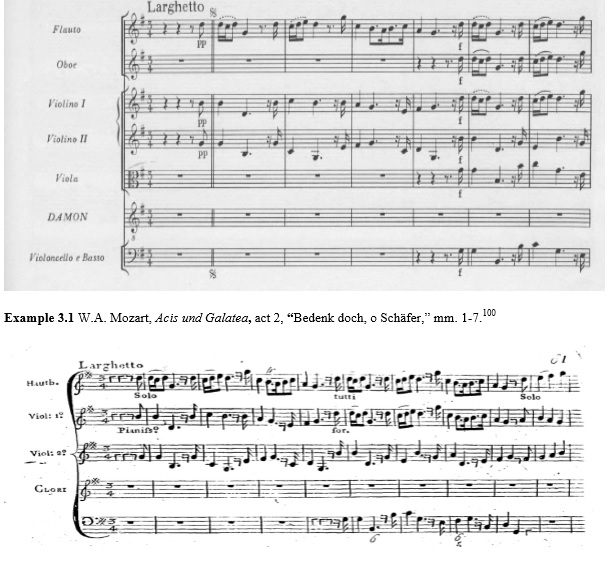 Example 3.2 G. F. Handel, Acis and Galatea, “Consider, Fond Shepherd,” mm. 1-10 Mozart retained all of Handel’s music from the 1718 version, but he added two movements, which he called an “Introduction” to the second part of the opera. Mozart pulled the music for this instrumental Introduction from two movements of Handel’s Concerto Grosso, op. 6. Both the Musette (HWV 324) and the Largo (HWV 325) create a fitting pastoral mood for the Introduction モーツァルトは、1718年版からのすべてのヘンデルの音楽を保持したが、第2部の最初に“Introduction” と呼ばれる2つの楽章を加えた。モーツァルトは、この声楽なしの“Introduction” のために、ヘンデルのConcerto Grosso, op. 6.の2つ楽章の音楽を引っ張り出した。 Musette(HWV 324)とLargo(HWV 325)の両方が、Introductionの牧歌的な雰囲気を醸し出している。 The first movement of the Introduction (Musette) is in three sections and moves from a slow dotted-rhythm motive to a rapid flourish of sixteenth notes. In the second section, in which the wind parts provide sustained chords over rhythmically charged string writing as seen in Example 3.3. The result is a contrast of sixteenth-note perpetual motion with fluid motion in the wind parts. Introduction(Musette)の最初の動きは、3つのセクションに分かれていて、遅い付点リズム動機から素早く華やかな16分音符へと変化する。第2部では、木管楽器は持続的和音を供給し、その間、弦楽器は in Example 3.3に示すように細かい16分音符のリズミカルな動きとなる。その結果、木管楽器の流れ的要素と弦楽器の16分音符の動きのコントラストが出現する。 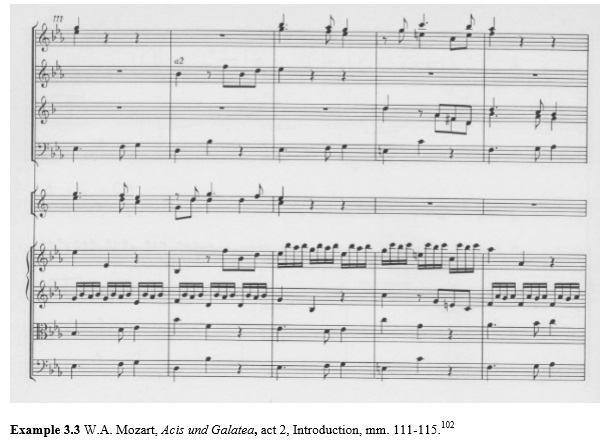 While this is typical by the time Mozart is in his mature phase of his career, Handel seldom juxtaposes the strings and woodwind parts like this in Acis and Galatea. The return to the initial idea suggests a ternary form. Following the cadence, a brief, almost recitative-like movement (Largo) transitions the larger preceding movement to the first chorus of the second act that follows. This ten-bar Largo facilitates the move from the E-flat major final chord of the Musette to the opening B-flat major chord of the initial chorus of the second act. これは、モーツァルトの時代には一般的なことであったが、ヘンデルはめったに弦楽器と木管楽器をこの「Acis and Galatea」ようには並置しなかった。3楽章構成に戻ると、カデンツ後、ほとんどレシタティーボ風のLargoが、引き続く第2部の最初の合唱に先立つ大規模な動きとなる。この10小節分のLargoは、Musettoの変ホ長調から第2部の最初の合唱の変ロ長調への以降の役割を担っている。 There are two arias in which Mozart made conspicuous alterations to the musical score by changing the time signature and substituting for the obbligato instrument. Yet these arias strongly resemble the orchestration of the Cannons score, especially in “Still, du kleines Wipfelchor” (“Hush, ye pretty warbling quire”) sung by Galatea and “Du roter als die Kirsche” (“Oh ruddier than the cherry”) sung by Polyphemus. Mozart scored both arias for two violins and viola with flute obbligato over a basso continuo as seen in Example 3.4. Mozart denoted the part as “Violoncello e Basso,” but he omits the figured bass line. This implies that basso continuo would not include keyboard.104 In Galatea’s aria, the time signature has been modified slightly from 9/16 to 3/8 as shown in Example 3.5.105 モーツァルトが拍子記号を変えてオブリガート楽器を代用することで、楽譜に目立った変化が出現したアリアが2つある。 これらのアリアはCannon版のオーケストレーションにきわめてよく似ている。特に、ガラテアによって歌われた "Still、du kleines Wipfelchor"( "Hush、ye pretty pretty warbling quire")やPolyphemusによって歌われる "Du roter als die Kirsche" (“Oh ruddier than the cherry”) において。 モーツァルトは、例3.4に見られるように、通奏低音にフルートのオブリガートを伴う2パートののヴァイオリン、ヴィオラの構成で書いている。モーツァルトは“Violoncello e Basso,”と記しているが、その数字付き低音は省略している。これは、通奏低音が鍵盤楽器を含まないことを示す。galateaのアリアにおいては、拍子記号が from 9/16 to 3/8 と変えられている。 104 Neff, “van Swieten,” 69. The keyboard available to Mozart for the private performance would mostly likely have been a harpsichord. However, the pianoforte or early piano might be a used as a suitable alternative. The keyboard would have been used only on the recitatives. 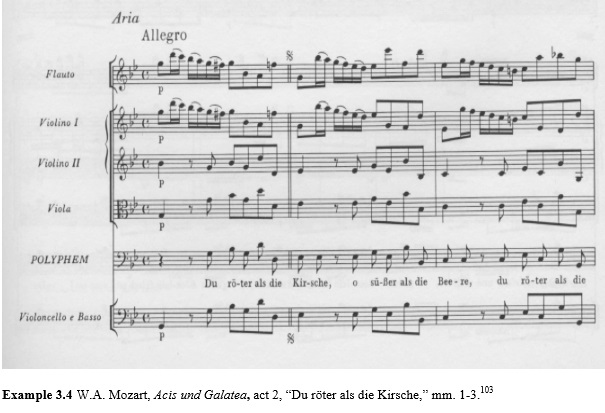 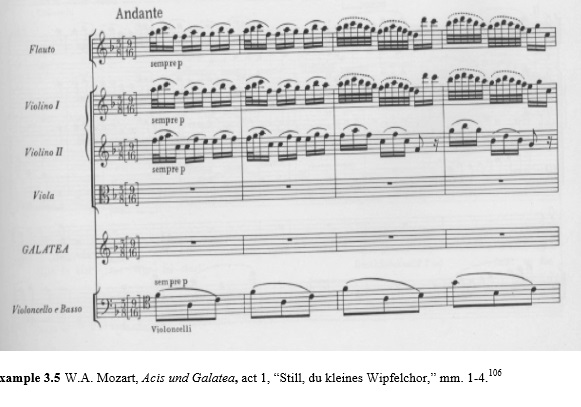 Handel’s score does change to 3/8 at the final cadence of the A-section to facilitate an implied ritardando and hemiola. Rather than importing this, Mozart begins the aria in 3/8 and retains that time signature throughout the aria. As part of the adaptation, Mozart substitutes the transverse flute for soprano recorder. The addition of the viola part amplifies the bass part, which is, at times, sounding in three octaves.107 Mozart notes, col bassi and sempre piano in measure 9. Lastly, Mozart adds the dynamic marking for all instrumental parts in the first measure, sempre piano and suggests certain specific phrasing and articulation by adding slurs in the obbligatopart--grouping the florid notes into eighth-note groupings. In the bass part, he slurs the whole measure and pairs notes together with the aforementioned articulation. The juxtaposition of articulation on the beat and whole measure amplifies both the meter and metric pulse. ヘンデルのスコアは、リタルダンドとヘミオラを容易にするために、Aセクションの最後のカデンツで3/8に変わる。 しかしモーツァルトは、3/8でアリアを開始し、アリアを通してその拍子を保持している。改訂の一環として、モーツァルトは横笛をソプラノ・レコーダーに置き換えている。 ビオラ・パートの追加によりバスパートを厚くし、時には3オクターブで奏せられる。モーツァルトはcol bassi 、 sempre piano と第9小節に記している。最後に。モーツァルトは、すべての楽器の最初の小節に強弱記号sempre pianoを書き加えている。そして、オブリガートパートにはスラーを付加し、特別なフレージングやアーティキュレーションを指示している。華やかな音符を8分音符と分けてグループ化している。バスパートでは、彼は小節全体にスラーをかけている。拍子におけるアーティキュレーションの並置と小節全体とは音律と韻律の動悸を増幅させる。 In the other similarly scored aria, Polyphemus’ aria “Du roster als die Kirsche,” (“O ruddier than the cherry”) much of the same adaptation process occurs. Mozart substituted the flute for recorder and scores the instrumentation with violin II, viola and bassi under the violin/flute obbligato. Unlike the former aria, there is no change in time signature, but there are significant changes to the dynamic markings, articulation, and musical material. The opening gesture is marked piano and the sixteenth-note descending scale pattern is slurred in pairs in the flute part. This projects an even couplet articulation of the sixteenth notes rather than an arrhythmic scale gesture. 同様にスコアリングされたアリアPolyphemus 'aria "Du roster als die Kirsche,"( “O ruddier than the cherry”)では、、多くの同じ改訂プロセスが発生する。モーツァルトは、フルートをリコーダーに代え、第2ヴァイオリン、ヴィオラ、ヴァイオリンとフルートのオブリガートの構成を取る。前のアリアと異なり、拍子記号には変化はないが、強弱記号、アーティキュレーション、および音楽素材に大きな変化がある。最初の部分はpと記され、フルートパートでは16分音符の下降スケールパターンが(第1ヴァイオリンと)ペアでスラーがつけられている。。これは、不規則なスケールの動きではなく、1分音符が一緒になった動きを示す。 While Mozart marked both the violin I and flute part identically, the 1718 score presents slurs in only the violin I part. Up to the beginning of the B-section, Mozart made subtle changes, which include the addition of slur markings and a viola part. However, here he composed a new flute obbligato for ten measures and completely altered the upper string parts in measures 37 through 41 in Examples 3.6 and 3.7. These measures are distinctly Mozartean, and his adding new music in the flute part avoids preserving the redundant unison part writing that is found in Handel’s score. このように、モーツァルトは第1ヴァイオリンとフルートのパートの両方を同じように記していたが、(ヘンデルの)1718年のスコアでは、第1バイオリンのみがスラーで記されている。 Bセクションの冒頭まで、モーツァルトはスラー記入とヴィオラパートの追加など、微妙な変更を加えた。しかし、ここで彼は、10小節にわたるフルートの新しいオブリガートを作曲し、Examples 3.6 and 3.7に見られるように、第1ヴァイオリンのパートを37小節から41小節にいたるまで、完全に変えてしまった。この部分は明らかに”モーツァルトの作品”であり、フルートパートにおける彼の新しい音楽の付加は、ヘンデルのスコアに見られる冗長なユニゾンパートを残すことを避けたのである。 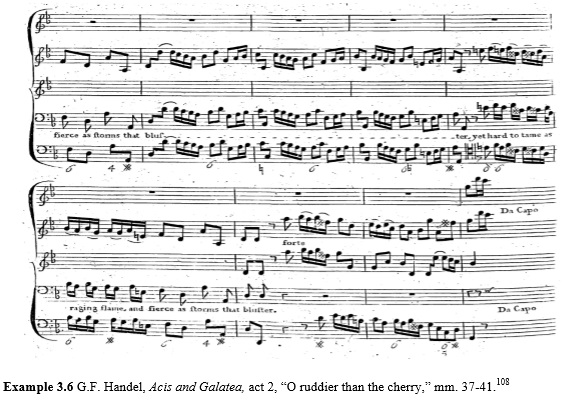 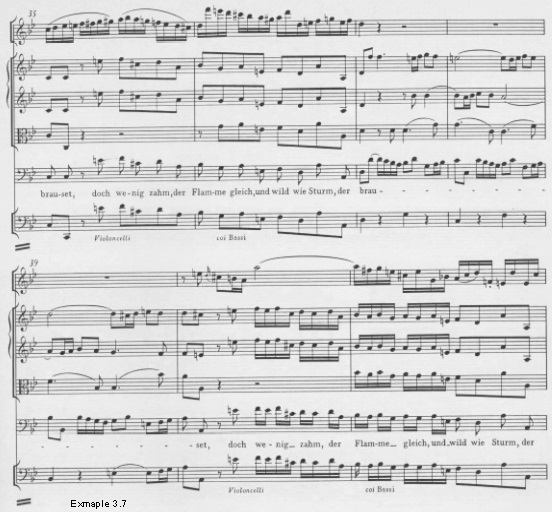 Most of the novelty of the Mozart adaptation is the addition of woodwind parts. The aria, “Lieb in ihr Aug’ verkrochen” (“Love in eyes is telling”) is scored for flute, two clarinets, two bassoons, and strings as shown in Examples 3.8 and 3.9.109 Based on the 1718 score, the flute, first clarinet, first bassoon (played an octave lower), and first violin parts are all in unison. Likewise, the second clarinet and second violin parts are paired, and the viola, second bassoon, and bassi parts are grouped. However, while this second bassoon part follows the contour of the bassi part, there are measures in which it is a third higher or sustaining a pitch rather than joining in a triplet eighth-note figure in measure 3. Much the same way a piece of music written in four parts can be filled out by pairing a part in a different octave, the scoring of this aria is similarly enlarged. モーツァルトの改訂の新規性の大部分は、木管楽器パートの追加である。 アリア “Lieb in ihr Aug’ verkrochen” (“Love in eyes is telling”)は、例3.8と3.9.109に示されているように、フルート、2つのクラリネット、2つのバスーン、弦楽器となっている。1718年版のスコアをベースとして、フルート、第1クラリネット、第1バス―ン、第1ヴァイオリンパートはすべてユニゾンである。同様に、第2クラリネット、第2ヴァイオリンはペアであり、ヴィオラ、第2バス―ン、バスパートがグループ化されている。しかし、第2バス―ンパートはバスパートをなぞっているわけであるが、バスおり3度高かったり、第3小節においては、(バスの)3連符の8分音符の動きをなぞるのではなく、むしろ一定のピッチを保ったりといった部分も見られる。同じように、 4パートで書かれた音楽は、異なるオクターブのパートをペアに書き入れることができる。このアリアのスコアも同様にそれが行われ、音楽全体が拡大されている。 When Acis begins to sing, the instrumentation drops down to strings and flute-reverting back to Handel’s scoring- except for the substitution of flute for oboe. With this movement, Mozart preserved one of the hallmarks of the eighteenth-century operatic style: a ritornello that only occurs when the soloist is not singing. The opening ritornello, for instance, is full of musicalcolor steeped in a pastoral mood complete with pipes, reeds, and drones. On the otherhand, while the soloist sings, the instrumentation is minimal and unobtrusive. Finally, Mozart’s markings for phrasing and articulation indicate legato playing. This is an important shift from the approach Handel used. The absence of such an articulation marking implies a standard of playing that was founded in performance practice compared to one that is explicit in how the phrases take shape on the page. Acisが歌い始めると、楽器は弦楽器とフルートのみに落とされる―ヘンデルのスコアに戻る―オーボエの変わりにフルートに代わっているのを除いて。この楽章においては、モーツァルトは18世紀のオペラスタイルの特徴の1つを保っている。ソリストが歌わないときにのみリトルネルロとなる。 例えば、リトルネルロのオープニングは、パイプ、リード、ドローンの牧歌的な雰囲気の中で彩られた音楽的なものでいっぱいである。 一方、ソリストが歌いながら、楽器は最小限で邪魔になっていない。 最後に、モーツァルトのフレーズとアーティキュレーションの記入は、レガート演奏を示している。 これは、Handelが使用したアプローチからの重要な転換である。 このようなアーティキュレーションの記入がないことは、フレーズがどのようにページ上で形成されるかを明らかにするものと比較される実践で見いだされる演奏標準を示している。 Another remarkable departure from Handel’s score is identified in Damon’s aria, “Strebst du nach der zarten Schonen” (“Would you gain”) as shown in Examples 3.10 and 3.11. For this aria, Mozart takes three parts found in the 1718 score and adds flute, bassoon, a second violin, and viola. Unlike “Lieb in ihr Aug’ verkrochen,” (“Love in her eyes is telling”), Mozart did not double the parts. Instead he broadened the instrumental color. Beginning in measure six of the opening ritornello, he is composing new musical material. In a call-and-response among the first iolin, the flute, and bassoon, there are vestiges of the birdcalls heard in Galatea’s aria, “Hush, ye pretty warbling quire.” Indeed, the paired woodwinds expand the musical color, but the success of Mozart’s adaptation lies in the sections that are not instrumental ritornello. When the soloist enters, Mozart couples the violin with the tenor as it is in Handel’s score. Handelのスコアからの別の独自例は、例3.10と3.11に示すDamonのアリア「Strebst du nach der zarten Schonen」(“Would you gain”)である。このアリアのために、モーツァルトは1718年版のスコアの3パート部分に手を入れ、フルート、バスーン、第2ヴァイオリン、そしてビオラを加えている。“Lieb in ihr Aug’ verkrochen,” (“Love in her eyes is telling”)とは違って、各パートをダブルにはしなかった。代わりに、彼は楽器の色を広げた。オープニングリトネロの第6小節から、彼は新しい音楽素材を使っている。第1ヴァイオリン、フルート、そしてバスーンの間でのcall-and-responseでは、ガラテアのアリア“Hush, ye pretty warbling quire.”で聞かれた鳥の鳴き声の痕跡がある。確かに、対になった木管楽器は音楽の色を広げている。しかし、(この曲の)モーツァルトの改訂の成功は、楽器のないリトネロセクションにある。ソリストが入ると、モーツァルトはヘンデルのスコアと同じように、第1ヴァイオリンとテノールを一組とする。 However, he also includes moments of instrumental interjections throughout the aria. Instances where the violin dominates before being overtaken by the flute just prior to the cascading bassoon line and its decorative motive that sinks into the texture. In these sections, Mozart is interjecting new musical material. He builds on the off-the-beat lilt and the rising sequence to create an aria that sounds more like Mozart than Handel. In sum, Mozart is adding instruments without substitution and he solidifies the dynamic contrast between ritornello and vocal solo by inserting dynamic markings. Starting an aria with minimal scoring, Mozart energizes the instrumentation in his adaptation that goes beyond fundamental arrangement. しかし、彼はまた、アリア全体で、器楽的相互関係をも考慮している。ヴァイオリンが、ちょうど下降するバス―ンや装飾動機に優先しているフルートに追い越される前に支配的になる場所である。この場所で、モーツァルトは新しい音楽素材を投入している。彼はoff beatの歌や、上昇音型の利用などをして、ヘンデルよりもモーツアルト風に聞こえるアリアを作り出している。要するに、モーツァルトは、楽器を代用ではなく追加しており、強弱記号を記入することで、リトルネルロとボーカルソロの間のダイナミックなコントラストを固めている。最小の楽器使用でアリアを開始し、モーツァルトは、基本的な編曲arrangementを超えた改訂adaptationによって、器楽を活性化している。 The duet and chorus that concludes the first section provides an example of an inconspicuous change. While Mozart uses John Walsh’s first edition printing to make his adaptation, this movement more than all the rest presents a substantial dilemma. When Acis and Galatea was premiered in 1718, the duet was in the rounded binary form.115 In the 1743-printed edition, the form of the duet is rounded binary followed by yet another reprise of the A-section sung as a chorus. The repeat of the A-section by the chorus is the one anachronism of the 1743printed edition when compared with the Cannons score. This creates a slight discrepancy in the chronology of the form of the duet. Nevertheless, in Mozart’s adaptation, the duet returns to the A-section by way of the da capo del segno before segue into the chorus.116 第1部を終えるデュエットとコーラス(Happy,happy)は、目立たない変化の1例である。 モーツァルトは、自身の改訂をするためにJohn Walshの第1版(印刷版)を使っているが、この楽章においては、残りのすべてよりも大きなジレンマが出てくる。「 AcisとGalatea」が1718年に初演されたとき、デュエットは2部形式であった. 1743年の印刷版では、デュエットの形は2部形式に続いて、Aセクションがコーラスとして歌われた。 合唱によるAセクションの繰り返しは、Cannon版のスコアと比較したときの1743年の版の時代錯誤である。 これは、デュエットの形式の年代順にわずかな不一致を生じさせる。 それにもかかわらず、モーツァルトの編曲では、デュエットはda capo del segnoの方法でAセクションに戻り、segueの前に合唱に戻る。 116 In the 1739 revival of the Cannon’s Acis and Galatea, Handel composed an extended chorus with carillon to be inserted immediately following the B-section of the duet. We are left wondering why Mozart does not include the extended musical material of the chorus. As to be expected, this chorus is scored with the full instrumentation that we find in nearly all the other choruses and the overture. The instrumentation mostly doubles the parts in the 1718 score and Mozart takes a more conservative approach to adapting this duet and the subsequent chorus. The novelty of this movement is the varied instrumental color heard among the strings. When the chorus enters, the woodwinds no longer double the string parts, but rather the vocal lines. Not only does Mozart essentially preserve Handel’s orchestration, he also makes little if any additions to the musical notation. In the end, Mozart’s cautious adaptation of these two movements indicates more about his capacity to be sensitive to what movements were ripe for change and which movements required only minor alteration. 予期されるように、この合唱は、フルオーケストラで書かれている。 この楽器群は、1718年のスコアのほとんどのパートを2倍にし、モーツァルトはより保守的なアプローチでこのデュエットと引き続く合唱を編曲している。この楽章の真新しさは、弦楽器群の間での楽器の音色で変化している。 合唱が入ると、木管楽器はもはや弦楽器のパートを2倍にするのではなく、合唱ラインを2倍にする。 モーツァルトは本質的にヘンデルのオーケストレーションを保存するだけでなく、音楽表記の追加もほとんど行なっていない。 結局、これらの2つの楽章のモーツァルトの注意深い改訂は、どの楽章が変化にために熟していたのか、どの楽章がより少ない変化しか求めていなかったのかについての感受性能力が優れていたことを示しているのである。 Conclusion Mozart’s adaptation reflects a transitory period between the performance practice of Handel’s time in Cannons and the musical tastes of 1780s Vienna. Mozart’s adaptation is representative of the approach to early music in 1788, a performance of older music outside of its historical context. There are moments in the adaptation where Mozart conspicuously alters the score and then there are moments when the addition of a few woodwind parts update and expand the instrumental color. Furthermore, this adaptation reflects Mozart’s first attempt at updating a Handel score for his patron and supporters. Mozart’s opera, Acis und Galatea synthesizes the nature of the Viennese musical style and the first of Handel’s English musical dramas. This score lies in the middle of a string of transcriptions and arrangements, and therefore it is but an example of Mozart’s engagement with older music. モーツァルトの改訂は、Cannonでのヘンデル時代の演奏実践とウィーンの1780年代の音楽趣味との間の過渡期的な期間を反映している。 モーツァルトの編曲は、1788年の音楽へのアプローチを表している。 より古い音楽の実践はその歴史上の文脈の外側にある。モーツァルトが華やかにスコアを変え、いくつかの木管楽器の追加が楽器の音色を抑止、拡大する時期がある。 さらにこの編曲は、彼の後援者と支持者のために、ヘンデルのスコアを新たにするモーツァルトの最初の試みを反映している。 モーツァルトのオペラ、「Acis und Galatea 」は、ウィーンの音楽スタイルの性質と、ヘンデルの最初の英語の音楽ドラマの綜合である。 このスコアは、写譜と編曲のつながりの中間であり、それゆえにこれは、モーツァルトのより古い音楽とのかかわりの一例に過ぎない。 |